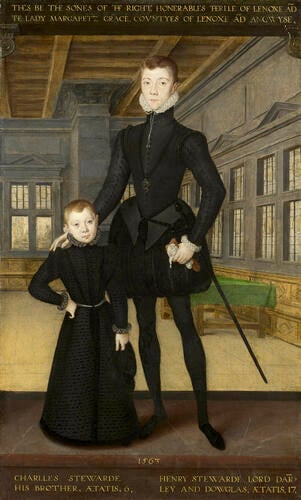-
1 of 253523 objects
Henry Stewart, Lord Darnley and his brother Charles Stewart, Earl of Lennox 1563
Oil on panel | 63.3 x 38.0 cm (support, canvas/panel/stretcher external) | RCIN 403432
-
Henry Stewart was 17 and Charles 6 when this portrait was painted, according to the inscription. Henry had only 4 more years to live. Through his grandmother, Margaret Tudor, sister of Henry VIII, Darnley had claims to the English throne and his mother was keen to arrange his marriage to the young Mary Queen of Scots (1542-87). In February 1565, 2 years after this painting was made, Darnley travelled to Edinburgh and attended the Scottish Queen, dancing a flirtatious galliard with her. Sir James Melville thought him ‘liker a woman than a man’ and ‘beardless and baby-faced’ but Mary described him as ‘the properest and best-proportioned long man that ever she had seen’. They were married at Holyrood chapel on 29 July 1565 and Darnley was proclaimed King of Scotland.
The marriage was unhappy, however, and Mary turned increasingly to her Italian secretary, David Rizzio. A group of disaffected nobles involved Darnley in a plot to kill Rizzio, who was murdered in the presence of the pregnant Queen on 9 March 1566. On 19 June 1566 Mary and Darnley’s son, James, the future James I of England, was born. Towards the end of 1566 Mary and her lords of council met to discuss the ‘Darnley problem’ seeking ‘the means that your majesty shall be quit of him without prejudice to your son’, according to a contemporary record. Early the next year, a group of nobles, led by Lord Bothwell, laid gunpowder in the cellar of his home and blew it up. The bodies of Darnley and his servant were found under a tree in the garden, apparently suffocated while trying to escape. Beside them were a chair, a dagger, a coat, and a cloak. Darnley was 21 years old. He was buried in the vaults of the royal chapel at Holyrood.
Henry holds a white embroidered handkerchief and his gloves, and has a gold ring on his little finger. He wears the tight-fitting doublet and pumpkin-shaped trunk-hose particularly fashionable for adults at this date. A watch and key hang by a black ribbon round his neck. Charles Stewart retains the skirts worn by infant boys. Young boys wore dresses until they were 'breeched' (given their first outfit which included breeches or trousers) usually some time between the ages of 4 to 8 years old. Both outfits are constructed of black fabrics, their textures enlivened through the use of tiny pinked cuts in the surface. Lord Darnley’s ruff and cuffs are of pure white linen – a sign of cleanliness in both body and mind, while those of the younger brother are decorated with blackwork embroidery.
The painting was probably made for the boys’ parents. It is recorded in the Queen’s Gallery at Greenwich in 1639: ‘upon the right light in little at length the king’s grandfather with his brother … in his coat in a perspective chamber wherein a green table’. The painter’s monogram, HE, can be seen on the legs of the table. After the execution of Charles I it was valued at £6 and sold, but recovered after the Restoration and hung at Whitehall. There are slight pentimenti (changes made by the artist) in Lord Darnley’s legs, in the right hand of Charles and in the left outline of his ‘coats’. There are also traces of carved decoration under the present ceiling in the interior in the background. The artist appears to have referred to a print by Vredeman de Vries in Scenographie (1560), for the interior backdrop of the painting. De Vries (1527-1606) trained in Amsterdam but later moved to Antwerp.
Hans Eworth was listed as ‘Jan Euworts' in 1540 as a freeman of the Guild of St Luke in Antwerp (St Luke was the patron saint of painters), but by 1545 he had moved to England where he remained until his death in 1574. As well as working for the Office of Revels, designing sets and costumes for Elizabeth I’s court entertainments, Eworth also produced complex allegorical and religious works. Eworth was the principal court portrait painter during the reign (1553–8) of the Catholic Queen Mary Tudor and received the large majority of his portrait commissions from Catholic patrons. In 1572, after the death of the Serjeant-Painter, who would customarily have been in charge of royal festivals, he was called in to design decorations and costumes for the celebrations in honour of the arrival of ambassadors from France.
Signed on the table: HE (in monogram); inscribed on the bottom: THES BE THE SONNES OF THE RIGHTE HONERABLES THERLLE OF LENOXE AD / THE LADY MARGARETZ GRACE COVNTYES OF LENOXE AD ANGWYSE, / 1563 / HENRY SETARDE LORD DAR: / LEY AND DOWGLAS, AETATIS, 17, / CHARLES STEWARDE / HIS BROTHER, AETATIS, 6,Provenance
Thought to have been painted for the boys' parents and thus probably passed by descent from their mother to her grandson James I; recorded in the Queen's Gallery at Greenwich in 1639 (no 35); sold from there to Murray and others on 23 October 1651 for £6 (no 120); recovered at the Restoration and listed in the Long Matted Gallery at Whitehall in 1666 (no 17)
-
Creator(s)
-
Medium and techniques
Oil on panel
Measurements
63.3 x 38.0 cm (support, canvas/panel/stretcher external)
76.5 x 51.5 x 4.0 cm (frame, external)
Category
Object type(s)
Other number(s)
Alternative title(s)
Henry Stewart, Lord Darnley (1545-1567), and his brother Charles Stewart, Earl of Lennox (1555-1576)
